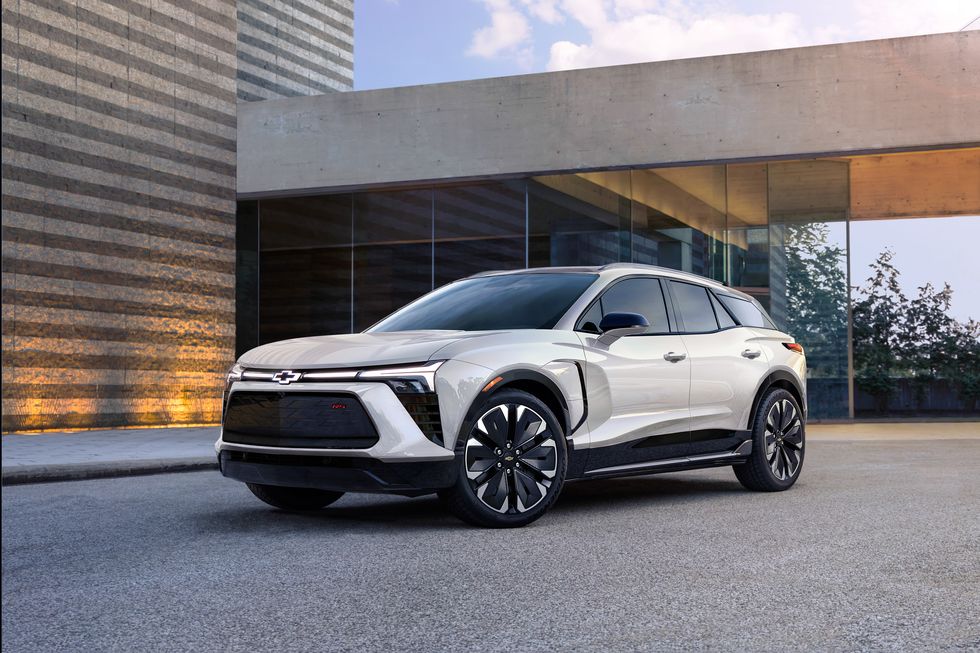Contents
2024 Chevrolet Blazer EV vs Hyundai Ioniq 5: What To Choose?
In 2019, Chevrolet revived the Blazer as a two-row mid-size crossover, disappointing fans of the original seeking an off-road SUV. Now, the Blazer EV enters the electric arena for 2024, boasting General Motors’ Ultium battery tech. The Blazer EV includes an SS trim with 557 hp and 0-60 mph in under four seconds. The RS trim offers the most range, reaching up to 324 miles on a single charge. In contrast, the Hyundai Ioniq 5 embraces its boxy design and offers various models, starting with a single-motor RWD version with 168 hp and a 220-mile range. The Ioniq 5’s standout feature is its 350-kW DC fast-charging capability, making it an attractive option for those entering the EV world with ample rear-passenger space compared to competitors.
| Chevrolet Blazer EV | Hyundai Ioniq 5 | |
| Dimensions | 192.2 in x 78.0 in x 65.0 in | 182.5 in x 74.4 in x 63.0 in |
| Motor | permanent-magnet synchronous AC | permanent-magnet synchronous AC |
| Horsepower | 340 hp | 320 hp |
| Torque | 325 lb-ft | 446 lb-ft |
| 0-60 MPH | 5.7-6.1 sec | 4.5 sec |
| 0-100 MPH | NA | 12.6 sec |
| Top-Speed | 118 mph | 117 mph |
Chevrolet Blazer EV

Motor & Performance
The starting LT model offers a choice between FWD and AWD. While the RS gives you the option for RWD or AWD. AWD versions, regardless of trim, pack two electric motors, giving a combined 288 hp. Now, if you opt for the RWD RS. It kicks it up a notch with a more powerful single motor, delivering a robust 340 hp. For the cream of the crop, the top-tier SS model exclusively features a 557-hp electric powertrain with standard AWD. The RWD drive RS claims the highest EPA estimated driving range at 324 miles. But if you go for the AWD version, that drops a bit to 279 miles. Similar to the AWD LT. When it comes to charging, the Blazer EV is no slouch.
Price & Mileage
If we were choosing, we’d opt for the RWD RS model to get the most out of the Blazer’s driving range. The Blazer EV lineup starts at $56,715 for the LT eAWD and climbs to $65,995 for the SS. According to the EPA, the Blazer EV RS boasts up to 103 MPGe in the city and 88 MPGe on the highway. These numbers apply to the all-wheel drive RS if you go for the RWD version. The estimates dip slightly to 101 MPGe in the city and 85 MPGe on the highway.
Acceleration & Features
Chevy claims the SS variant will hit 60 mph in under 4.0 seconds. Every model gets a sizable 17.7-inch infotainment display. Slightly angled towards the driver, with physical controls for climate and volume knob. Another 11.0-inch display serves up gauges and driving info. The Blazer EV’s infotainment is the latest from GM. Rocking Google Built-In for easy access to apps like Spotify, Waze, and Google Maps. While it’s cool with those apps, there’s no Apple CarPlay or Android Auto connectivity on this ride.
Hyundai Ioniq 5

Motor & Performance
The Ioniq 5 boasts an electric-only powertrain, offering various power levels. The standard-range battery, coupled with a single, rear-mounted electric motor, churns out 168 hp. Opting for the longer-range battery in the RWD configuration elevates the power to 225 hp and 258 lb-ft of torque. The AWD version takes things up a notch, boasting a robust 320 hp and an impressive 446 lb-ft. Fitted with the standard 58.0-kWh battery pack, the Ioniq 5 is estimated to cover 220 miles on a single charge. Upgrade to the larger 77.4-kWh pack, and the range extends to 266 miles with dual motors and 303 miles with a single motor. In terms of charging, Hyundai claims the larger battery can go from 10 to 80 per cent in around 18 minutes with a DC fast charger, adding 68 miles in just about five minutes.
Price & Mileage
Opting for the larger Ioniq 5 ensures a substantial journey ahead. The journey begins at $42,985 for the SE model and reaches $54,685 for the Limited variant. The Ioniq 5 is equipped with a long-range battery and RWD boasts an impressive combined EPA rating of 114 MPGe. Introducing AWD trims lowers the estimate to 101 MPGe. For those favouring RWD with the standard-range battery, the battery-electric SUV is anticipated to achieve a commendable 113 MPGe combined.
Acceleration & Features
The Long-Range with RWD is projected by Hyundai to accelerate the Ioniq 5 to 60 mph in 7.4 seconds. On the other hand, an AWD Ioniq 5 achieved a swift 4.5 seconds to reach 60 mph during testing on a track. Hyundai emphasizes connected living through the Ioniq sub-brand, and the Ioniq 5 reflects this commitment with a plethora of innovative infotainment and connectivity features. Taking centre stage is a 12.0-inch touchscreen sharing a panel on the dashboard with a 12.0-inch digital gauge cluster, with the former serving as the central hub for entertainment. This encompasses voice-recognition software, Apple CarPlay, and Android Auto, although, regrettably, the integration of Apple and Android smartphones necessitates the use of wires.

